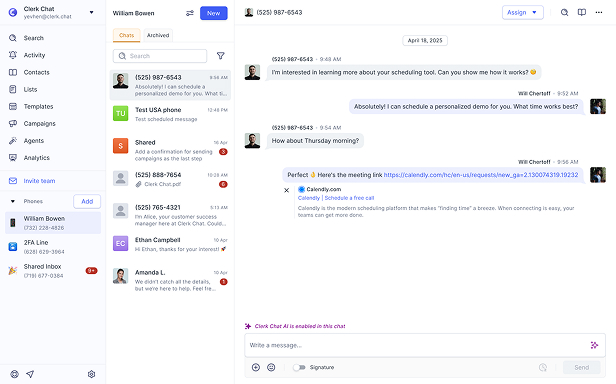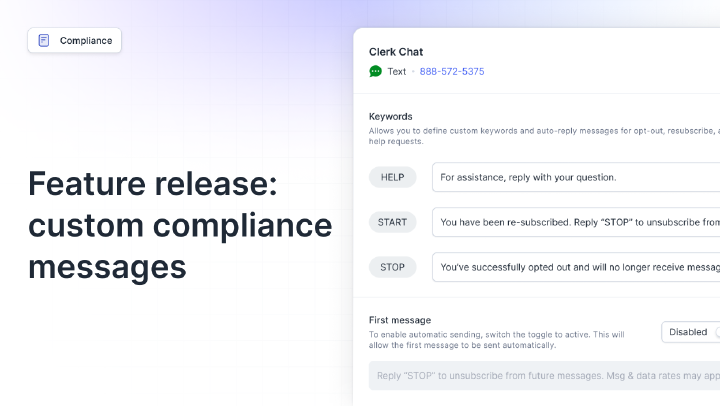RCS
[ɑr si ɛs]RCS (Rich Communication Services) represents the evolution of SMS into a feature-rich messaging protocol that enables businesses to send interactive, branded messages with media, buttons, and real-time features. By combining the universal reach of SMS with app-like functionality, RCS delivers 35% higher engagement rates while maintaining the trust of carrier-based messaging.
Why RCS Matters
The shift to RCS addresses a fundamental disconnect in business messaging. While customers expect rich, interactive experiences from every digital touchpoint, traditional SMS remains stuck in 1992 with plain text limitations. RCS bridges this 30-year gap by bringing modern messaging features directly to customers’ default texting apps—no downloads, passwords, or app switching required.
For businesses, RCS transforms basic notifications into revenue-generating conversations. Financial institutions using RCS report 45% reduction in fraud through verified sender badges that combat SMS phishing. Retailers leveraging product carousels within RCS messages see purchase rates jump 35% compared to text-only SMS. Airlines sending interactive boarding passes via RCS reduce check-in support calls by 50%.
The timing for RCS adoption has never been better. With Apple adding RCS support to iPhones in 2024, the protocol now reaches over 2 billion devices globally. Forward-thinking companies using platforms like Clerk Chat are already building RCS strategies that differentiate their customer communications. As messaging moves from utility to experience, RCS provides the tools to create memorable interactions that drive both satisfaction and sales.
How RCS Works
RCS operates through a sophisticated infrastructure that maintains SMS reliability while adding rich features:
Business Verification: Before sending RCS messages, businesses complete verification with Google’s RCS Business Messaging platform, establishing trusted sender identity with official branding.
Message Creation: Your platform composes RCS messages using JSON formatting that includes text, media URLs, interactive elements, and branding components within an 8,000-character limit.
Capability Check: The RCS system checks if the recipient’s device and carrier support RCS. This happens in milliseconds through carrier databases and device polling.
Smart Routing: If RCS is supported, messages route through data channels (WiFi or mobile data). If not, the system automatically falls back to SMS/MMS for universal delivery.
Rich Rendering: Recipients see branded messages with your company logo, verification badge, typing indicators, and all rich media elements rendered natively in their messaging app.
Real-Time Interaction: Unlike SMS’s one-way nature, RCS maintains an active session. Users see typing indicators, delivery receipts turn to read receipts, and interactions with buttons trigger immediate responses.
Analytics Collection: Every interaction generates detailed analytics—from message opens to button clicks to conversion events—providing insights impossible with traditional SMS.
Best Practices with RCS
Design Mobile-First Rich Cards - Create rich cards with clear visual hierarchy. Use high-contrast text over images, limit to 2-3 action buttons maximum, and ensure critical information remains visible even if images fail to load.
Leverage Suggested Replies Strategically - Offer 3-4 suggested reply chips that guide conversations naturally. Use action-oriented language like “View Details” or “Schedule Now” rather than generic “Yes/No” options.
Build Trust with Verified Sender Features - Maximize your verified business profile with professional logos, brand colors, and clear business descriptions. This verification badge increases message trust by 73%.
Create Conversational Message Flows - Design RCS campaigns as conversations, not broadcasts. Use typing indicators before sending follow-ups and acknowledge user interactions immediately with contextual responses.
Optimize Media for Quick Loading - While RCS supports large files, optimize images to 1-2MB and videos to 10MB maximum. Faster loading increases engagement completion rates by 40%.
Implement Smart Fallback Strategies - Always design RCS messages with SMS fallback in mind. Ensure core information and calls-to-action work effectively even in plain text format for non-RCS devices.
Measure Interactive Element Performance - Track which buttons, cards, and suggested replies generate highest engagement. Use this data to refine your RCS templates and improve conversion rates continuously.
Real world examples
Common misconceptions
RCS requires data connectivity and smartphone compatibility, while SMS works everywhere. Both will coexist for years.
Only about 60% of smartphones globally support RCS, with iOS adoption beginning in late 2024.
RCS Business Messaging doesn't include end-to-end encryption, though Google's consumer RCS does between Android users.
RCS typically costs 2-4x more than SMS but delivers 35% higher conversion rates for businesses.
Related terms
In this article:
Ready to use your business number for text messaging?
Thousands of businesses are already experiencing the power of conversational messaging through SMS. Join us. Free trial and paid tiers available.
Get StartedFAQ
Have questions? We've got answers.
Find what you need quickly and clearly with our most frequently asked questions.
RCS (Rich Communication Services) is the next-generation messaging protocol that adds modern chat features to standard texting. It enables businesses to send branded messages with company logos, rich media cards, suggested action buttons, carousels of products, and real-time typing indicators. Unlike SMS's 160-character limit, RCS supports 8,000 characters plus high-resolution images and videos, creating app-like experiences within native messaging.
Implementing RCS requires partnering with an RCS-enabled platform like Clerk Chat and getting approved as a verified business sender. First, register your business with Google's RCS Business Messaging program, which includes verification of your company identity and use cases. Create your branded sender profile with logos and colors. Then configure message templates following RCS guidelines. The approval process typically takes 2-4 weeks, after which you can start sending rich interactive messages.
RCS messages cost approximately $0.02-0.08 per message, roughly 2-4 times SMS pricing. However, the rich features often deliver superior ROI. For example, a clothing retailer might spend $400 to send RCS messages with product carousels to 5,000 customers but generate $12,000 in sales from the 35% higher engagement rates. Costs vary by country and volume, with enterprise agreements offering better rates.
RCS works on most Android devices (Android 5.0+) through Google Messages and Samsung Messages. Apple added RCS support to iPhones with iOS 18 in late 2024. Major carriers including Verizon, AT&T, T-Mobile, and most international providers support RCS. However, coverage varies by region—check carrier compatibility before launching campaigns. Messages automatically fall back to SMS/MMS for unsupported devices.
RCS supports high-resolution images (up to 10MB), videos (up to 100MB), audio files, location sharing with interactive maps, rich cards with multiple elements, product carousels showcasing up to 10 items, suggested reply buttons, action buttons linking to websites/apps/phone calls, calendar event creation, and payment integration. Messages can include your brand colors, logos, and custom fonts for consistent brand experience.
RCS provides detailed delivery insights including sent, delivered, read, and interaction metrics—far beyond SMS's basic delivery confirmation. You can track which buttons users click, how long they view content, and conversion paths. Read receipts show exactly when customers engage with messages. This granular data enables optimization of message timing, content, and call-to-action placement for maximum effectiveness.




